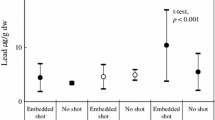Abstract
The concentrations of lead in the femura (Pb-F) and the 5-aminolaevulinic-acid-dehydratase in blood (ALA-D) have been determined in three pigeon populations (50 birds each), caught at urban sites with different traffic densities. The following mean concentrations were found (Pb-F [mg/kg wet wt.]/ALA-D [U/I]): 10.7/18.8 in the low burdened group, 27.9/10.8 in the moderate burdened group, and 49.5/5.6 in the high burdened group. These values were compared with a controlled group of 50 farm pigeons from two remote pigeonries, sited well away from motorways (Pb-F: 1.0/ALA-D: 35.6). The result was a strong positive correlation of the Pb-F and an inverse correlation of the ALA-D to the number of cars per day at the different sites. These local effects contributed much more to the differences of the Pb-F and ALA-D (in comparison with the rural pigeons) than the over-all elevated lead background level in the city. It has been concluded that the pigeon is an almost ideal animal for monitoring a narrow range of environmental lead burden. The main reason for this is that this species is exceptionally stationary; the usual ranges of the feeding, nesting, and sleeping sites of the pigeon are not greater than several hundred meters.
Similar content being viewed by others
References
Berlin, A. and Schaller, K.-H.: 1974, ‘European Standardized Method for the Detection of d-Aminolevulinic Acid Dehydratase Activity in Blood’, Klin. Chem. Klin. Biochem. 12, 389.
Drasch, G: 1982, ‘Lead Burden in Prehistorical, Historical and Modern Human Bones’, Sci. Tot. Environm. 24, 199–231.
Drash, G.: 1985, ‘A Comparison of the Lead Concentrations of Human Bones 1974–1984, in T. D. Lekkas (ed.) Int. conference “Heavy Metals in the Environment”, Athen, Sept. 1985. Proceedings CEP Consultants Ltd, Edinburgh, U.K., pp. 433–435.
Ellenberg, H., Dietrich, J., Stoeppler, M., and Nürnberg, H. W.: 1985, ‘Environmental Monitoring of Heavy Metals with Birds as Pollution Integrating Biomonitors I. Introduction, Definitions and Practical Examples for Goshawk (Accipiter gentilis)’ in T. D. Lekkas (ed.) Int. conference “Heavy Metals in the Environment”, Athen, Sept. 1985. Proceedings CEP Consultants Ltd, Edinburgh, U.K., pp. 724–726.
Ewers, U. and Schlipköter, H.-W.: 1984, ‘Blei’, in E., Merian (ed.), Metalle in der Umwelt, Verlag Chemie, Weinheim, F.R.G.
Hahn, E., Ostapczuk, P., Ellenberg, H., and Stoeppler, M.: 1985, ‘Environmental Monitoring of Heavy Metals with Birds as Pollution Integrating Biomonitors II. Cadmium, Lead and Copper in Magpie (Pica pica) Feathers from a Heavily Polluted and a Control Area’, in T. D. Lekkas (ed.) Int. conference “Heavy Metals in the Environment”, Athen, Sept. 1985. Proceedings CEP Consultants Ltd, Edinburgh, U.K., pp. 721–723.
Hutton, M.: 1980, ‘Metal Contamination of Feral Pigeon, Columba Livia from the London Area’, Environm. Pollut. 22, 207–217 (Part I), 22, 281–293 (Part II).
Luepke, N. P. (ed.): 1979, Monitoring Environmental Materials and Specimen Banking, Martinus Nijhoff Publishers.
Moder, S.: 1983, ‘Beeinflussung der d-Aminolävulinsäure-Dehydratase (d-ALA-D) von Tauben (columba livia, forma urbana) nach Implantation von Bleiprojektilen und Beurteilung der Korrosion der Geschosse’, Diss. Ludwig-Maximilians-University Munich.
Ohi, G.: 1974, ‘The Pigeon as Sensor of Lead Pollution’, Bull. Environm. Contam. Toxicol. 12, 92–97.
Umweltbundesamt (ed.): 1980. Berichte 9.
Vogel, K.: 1980, Die Taube. Biologie, Haltung, Fütterung, Landwirtschaftsverlag, Berlin, F.R.G.
Walser, D.: 1984, ‘Die Stadttaube (Columba livia, forma urbana) als Bioindikator für die Umweltbelastung mit Blei am Beispiel München’, Diss. Ludwig-Maximilians-University Munich.
Weyers, B., Glück, E., and Stoeppler, M.: 1985, ‘Environmental Monitoring of Heavy Metals with Birds as Pollution Integrating Biomonitors III. Fate and Content of Trace Metals in Blackbirds Food, Organs and Feathers for a Highly Polluted and a Control Area’, in T. D. Lekkas (ed.) Int. Conference “Heavy Metals in the Environment”, Athen, Sept. 1985. Proceedings CEP Consultants Ltd, Edinburgh, U.K., pp. 718–720.
Wren, C. D.: 1986, ‘Mammals as Biological Monitors of Environmental Metal levels’, Environm. Monitor. Assess. 6, 127–144.
Author information
Authors and Affiliations
Rights and permissions
About this article
Cite this article
Drasch, G.A., Walser, D. & Kösters, J. The urban pigeon (Columba livia, Forma urbana) — A biomonitor for the lead burden of the environment. Environ Monit Assess 9, 223–232 (1987). https://doi.org/10.1007/BF00419896
Issue Date:
DOI: https://doi.org/10.1007/BF00419896




